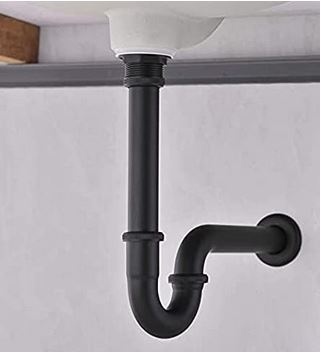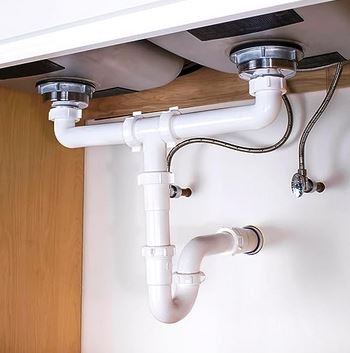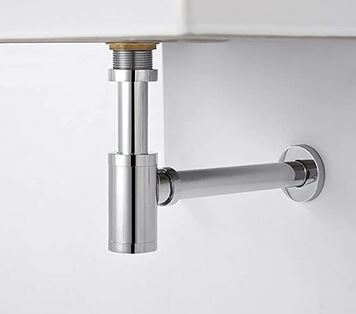Imagine the possibility of sewer gas from discharged wastewater returning to your household water. The risks are pretty dire, and that’s why you may need a washing machine p-trap when installing a new washer.
With a p-trap, you can stop sewer gas from flowing back from the sewer line upon discharge by your washing machine. Ultimately, that prevents the sewer gas from escaping into your home and becoming smelly or a fire hazard.
Not all washing machines, however, require a p-trap. Some don’t, especially those that drain into gray water tanks. I’ll explain more about this and why you may need a P-trap for your washing machine.
But first, let’s look at what a p-trap is, what it does, why it’s essential for washing machines, and what to do when it clogs, among other issues. Let’s get into it!

What Is a Washing Machine P Trap?
A p-trap is a p-shaped (as the name suggests) or u-shaped pipe that fits under the sink to stop sewer gases from finding their way into your home upon wastewater discharge.
By doing so, the p-trap also holds small foreign items like coins, pins, and jewelry from washing down the drain. So, you can quickly recover these items in the p-trap.
Even though it traps small foreign items and sewer gas, it allows other waste to pass and drain into the sewer line.
This p-shaped pipe connects the drain or standpipe with the washer’s drain hose. It holds some water, which enables it to stop sewer gas from flowing backward.
Do Washing Machines Need P Traps?
Not all washing machines need p-traps. P-traps are only necessary when the washing machine drains into the municipal sewer line or the home septic tank. You don’t need it if the washer drains to a gray water tank, as gray tanks don’t hold sewer water or kitchen wastewater, so the risk is small.
Generally, here are the reasons why p-traps are essential for washing machines that drain into the sewer line or septic tank:
- Stops sewer gas reverse flow – A p-trap uses water to keep sewer gases from returning to your home. In doing so, they prevent the noxious sewer gas smell and a possible fire outbreak resulting from the sewer gases.
- It’s a plumbing protocol – According to the Uniform Plumbing Code (UPC), washers that drain into the municipal sewer line should have a p-trap installed. If you don’t oblige with the directive, you may be liable for prosecution and hefty fines.
- Prevents clogging – Some items, such as coins, pens, jewelry, giant buttons, and many others, may escape down the drain. However, they are held in the p-trap before they can block it.
Washing Machine P-Trap Height
You don’t fit a p-trap just because the local plumbing code requires you to do so. You must observe the right height. Ideally, the UPC recommends a p-trap height of 6-18 inches – that is, the height from the floor.
If you go for less than 6 inches, the trapped water in the p-trap will likely evaporate and prevent the p-trap from doing its job. Moreover, if the water evaporates, the p-trap will run dry, and when it does, it’s likely to start smelling.
And if it’s higher than 18 inches, it may be hard to access and clean when it clogs or replace. Remember to consider your washing machine’s drain pipe height while at it and not just the p-trap height.

Washing Machine P Trap Clogged
Over time, the p-trap clogs up, requiring you to clean it. If you don’t, the p-trap may smell.
Generally, here’s how to clean washing machine p trap:
Option 1 – Use Drano
Consider using Drano, a commercial clog dissolver that doubles as a drain cleaner. Just ensure you follow the manufacturer’s instructions when using it.
Option 2 – Use a Drain Snake
You can also buy a drain snake or make one and use it to pull out clogs from the p-trap and other least accessible spots.
Option 2 – Clean with Salt Water
Use a cup of salt and 2 cups of water to make a cleaning solution. Then take out the p-trap and use the salt solution to clean it.
Step 4 – Use Baking Soda Solution
Mix baking soda and vinegar in hot water and use the solution to clean the p-trap. But just like in the first case, you must remove the p-trap to clean it.
Washing Machine P-Trap Smell
Although it’s the p-trap’s job to stop the sewer gas from flowing back and smelling, sometimes the trap could start smelling. That often happens due to these issues:
a) Dryness
The p-trap’s working principle depends on the water it holds as it’s the water’s role to absorb the sewer gases. If the p-trap runs dry, it’s unable to do its job and may instead start to smell. That will likely happen when you fail to use the washing machine for a while.
Fix
The solution for a dry p-trap is to add water to the dry p-trap before using the washer.
b) P-trap leakage
Due to wrong installation or physical damage to the p-trap, it may become faulty and start to smell.
Fix
Consider replacing the p-trap and ensure you install it correctly to avoid damaging it.
c) P-trap clogging
The p-trap could also start to smell because it’s clogged. Remember, the p-trap is often damp, which may attract mold growth, obstructing it. But still, it could be a case of some foreign materials finding their way into the p-trap.
Fix
Clean the p-trap to remove the clog. But if you can’t, pull the clog out with a drain snake.

What if My Washing Machine Drain Has No P-Trap?
If your washing machine has no p-trap, you’ve to ask yourself this question; where does it drain to? If the answer is the gray water tank, then there’s no need to worry, as your washer doesn’t need a p-trap.
However, if the answer is the municipal sewer line or septic tank, you should install a p-trap immediately. It’s advisable because it’s a plumbing protocol and safer.
You’ll need a new p-trap (View on Amazon), standpipe, drain hose, and hacksaw to cut the various pipes to size. And when you do, here’s how to install washing machine p trap:
- Determine the correct standpipe height – which should be 39-96 inches
- Cut the pipes (standpipe and drain hose) to size using a hacksaw
- Secure the standpipe to the nearest wall
- Connect the standpipe end to the p-trap
- Insert the washer’s drain hose into the standpipe to complete the p-trap installation
People Also Ask
1. Do All Washing Machines Have a Trap?
No. Though the p-trap is essential for the washer’s drainage, not all washing machines have it. It’s only recommended for washers that drain into the local sewer line or the septic tank. You, however, don’t need to feature it if your washer drains into the gray tank.
2. Does A Washing Machine Need an S-Trap or P-Trap?
A washing machine generally needs a p-trap that holds sewer gases from flowing back and causing havoc. You can stop the sewer gas smell and minimize the fire risk. The problem with an S-trap is that it dries out faster, making it ineffective for most washing machines.
3. What Is the Main Purpose of a P-Trap?
The main purpose of the p-trap is to hold sewer gases and prevent them from back flowing, causing a foul smell or becoming a fire hazard. It also helps your washer discharge other wastes without the sewer gases and holding foreign items that mistakenly find their way into the drain.
4. What Are the Problems with The P-Trap?
P-traps have different kinds of problems, often relating to not cleaning them properly and poor maintenance. For example, the p-trap may clog up with mold and become smelly. The p-trap may also become smelly when it runs dry and won’t absorb foul gases.
5. Where Should the P-Trap Be On a Washing Machine?
Ideally, the p-trap should be 6-18 inches off the ground. This small pipe connects the drain pipe to the drain hose, so it should be positioned between the two pipes. If you’ve doubts, check its installation instruction when you buy it.
6. How Far Can P-Trap Be from Washing Machine?
The Uniform Plumbing Code (UPC) recommends installing the p-trap 8-18 inches off the ground. If you install it lower than 6 inches, the chances of its trapped water drying up are very high, which may cause it to start smelling. And if you raise it above 18 inches, it may be hard to access and clean.
7. What Is the Difference Between the P-Trap and The S-Trap?
The difference between the P-trap and the S-trap is in their shapes. The p-trap, for example, flows downwards and curves horizontally just like the letter P, while the s-trap flows down and curves up and down just like the letter S.
8. Where Is an S-Trap Used?
An S-trap is used on plumbing fixtures where sewer gases are released. Its S-shape enables it to hold water, which traps sewer gases before they can flow back into your house. Moreover, it traps foreign objects from obstructing the drainage once they escape down the tub or sink.
9. Do All Front Loaders Have a Drain Pipe?
No. While most front loaders have a drain pipe that traps coins, socks, pins, and other foreign materials that escape as part of the washer’s discharge, not all have it.
10. How Do I Know If My P-Trap Is Not Working?
You can know if your p-trap is not working if the washer’s wastewater won’t go and find its way back. And if it does, then your house may start to smell. Moreover, the tub or sink may begin making a gurgling noise when trying to drain.
11. How Do I Know If My P-Trap Is Clogged?
You can know if your p-trap is clogged if there’s a sewer backflow. Of course, that may mean foul-smelling sewer gases or poor drainage. Whatever the case, you should clean the p-trap and remove anything clogging it.
Concluding Thought:
Now you know the washing machine p-trap, why and when you need it, and how to install it. You also know how to clean the trap and what to do when it becomes smelly.
And seeing that it’s a UPC plumbing requirement, you may want to install it as soon as possible if your washer drains into the municipal sewer line or a septic tank. You, however, don’t have to do anything if it drains to the gray tank.
